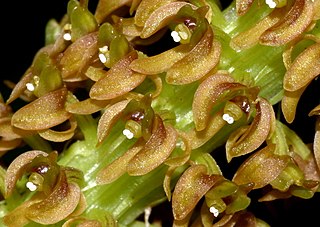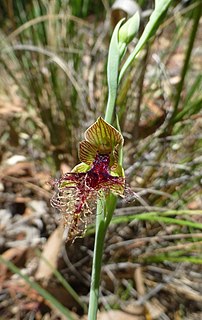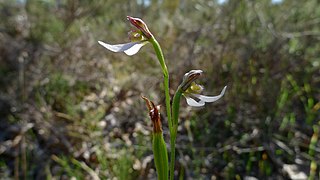
Crepidium, commonly known as 沼兰属 or spur orchids is a genus of about three hundred species of orchids in the family Orchidaceae. Plants in this genus are evergreen, mostly terrestrial plants with short stems lying on the ground, two or more relatively large, pleated leaves and small, non-resupinate flowers with spreading sepals and petals. The genus is widely distributed in the tropics.

Rimacola elliptica, commonly known as the green rock orchid or green beaks, is the only species of plant in the orchid genus Rimacola and is endemic to New South Wales. It is an evergreen species which grows in clumps in sandstone cracks and has bright green leaves and in late spring, produces arching flower stems with up to eighteen dull greenish flowers with reddish or brown markings. It only grows near Sydney, mainly in the Blue Mountains and near Fitzroy Falls.

Phaius robertsii, commonly known as forest swamp orchid, is a plant in the orchid family and is native to a small area of Tropical North Queensland and to New Caledonia. It is an evergreen, terrestrial herb with above-ground stems, three to five pleated leaves and up to twenty flowers which are yellow on the back and brick-red inside. It grows in wet places in rainforest.

Dienia ophrydis, commonly known as the common snout orchid or 无耳沼兰 is a plant in the orchid family and is native to endemic to a broad area of Asia, Southeast Asia, the Philippines, New Guinea and northern Australia. It is a deciduous, terrestrial orchid with a cone-shaped stem, bright green, wavy leaves and many greenish, brown, reddish or purplish flowers crowded on a wiry flowering stem.

Pterostylis erecta, commonly known as the upright maroonhood, is a species of orchid endemic to eastern Australia. Flowering plants have a rosette of four to seven stalked, dark green, crinkled leaves and a greenish to reddish-brown flower with a gap between the petals and lateral sepals. It occurs in New South Wales and south-eastern Queensland.
Pterostylis stenosepala, commonly known as the narrow-sepalled leafy greenhood, is a plant in the orchid family Orchidaceae and is endemic to New South Wales. Flowering plants have up to six shiny, translucent green flowers with darker green stripes. The flowers have an insect-like labellum which is green with a dark green mound on its upper end. Non-flowering plants have a rosette of leaves on a stalk, but flowering plants lack the rosette, instead having between four and eight stem leaves.
Genoplesium filiforme, commonly known as the glandular midge orchid is a small terrestrial orchid endemic to the east coast of Australia. It has a single thin leaf and up to thirty greenish to purple flowers with a reddish-purple labellum. The edges of its flower parts are covered with many short glandular hairs. It is found from southern Queensland to southern New South Wales.
Genoplesium acuminatum, commonly known as the pointed midge orchid and as Corunastylis acuminata in Australia, is a small terrestrial orchid endemic to eastern Australia. It has a single thin leaf fused to the flowering stem and up to sixteen small, hairy, greenish purple to brownish purple flowers. It is found in coastal and near-coastal parts of New South Wales and Queensland.
Genoplesium validum, commonly known as the Blackdown midge orchid, is a small terrestrial orchid endemic to the Blackdown Tableland National Park in Queensland. It has a single thin leaf fused to the flowering stem and up to thirty five greenish-brown flowers with reddish stripes and a hairy labellum.
Pterostylis orbiculata, commonly known as the coastal banded greenhood, is a plant in the orchid family Orchidaceae and is endemic to the south-west of Western Australia. The plants either have a rosette of leaves in the years when not flowering or stem leaves on a flowering spike. When flowering, it has up to twenty flowers that are reddish brown, greenish brown or green with a reddish or brownish labellum with short stiff hairs.

Calochilus therophilus, commonly known as the late beard orchid, is a species of orchid endemic to eastern Australia. It has a single channelled, dark green leaf with a reddish base and up to fifteen dull greenish flowers with bold red stripes. The labellum has a dark purplish beard with two "eye" spots. Unlike that of other beard orchids, there is no prominent ridge between the eye spots.

Eriochilus dilatatus, commonly known as the white bunny orchid, is a plant in the orchid family Orchidaceae and is endemic to Western Australia. It is a common and widespread, slender ground orchid with a single leaf and up to fifteen small white and greenish flowers with reddish or brownish markings and a hairy labellum.
Habenaria fuscina, commonly known as the green rein orchid, is a species of orchid that is endemic to Cape York Peninsula. It has two or three leaves at its base and up to fifteen small green and white flowers with a labellum shaped like a trident.

Crepidium fimbriatum, commonly known as the fringed spur orchid, is a plant in the orchid family and is endemic to tropical Far North Queensland. It is an evergreen, terrestrial orchid with a fleshy stem, wavy leaves and many purple flowers crowded on a purple flowering stem.
Crepidium flavovirens, commonly known as the green spur orchid, is a plant in the orchid family and is endemic to tropical far North Queensland. It is an evergreen, terrestrial orchid with a fleshy stem, wavy leaves and many yellowish green flowers crowded on a green flowering stem.
Crepidium fontinale, commonly known as the yellow spur orchid, is a plant in the orchid family and is endemic to the Northern Territory. It is an evergreen, terrestrial orchid with a fleshy stem, wavy leaves and many yellowish green flowers crowded on a green flowering stem.

Crepidium marsupichilum, commonly known as the pouched spur orchid, is a plant in the orchid family and is endemic to tropical far north Queensland. It is an evergreen, terrestrial orchid with an cone-shaped stem, light green, shiny leaves and a large number of purple flowers crowded along a green and purple flowering stem.
Tainia trinervis, commonly known as the ribbon orchid, is an evergreen, terrestrial plant with crowded pseudobulbs, each with a single smooth, shiny leaf and up to fourteen greenish to yellowish flowers with red or purplish stripes in the middle. It is found in tropical Southeast Asia, New Guinea and northern Australia.
Tropidia territorialis, commonly known as the striped crown orchid, is an evergreen, terrestrial plant with between three and six thin, pleated, dark green leaves and up to twenty crowded, green and white flowers. It is only known from about five places in the Northern Territory, Australia.

Dendrobium finniganense, commonly known as the Mount Finnigan cane orchid, is a species of terrestrial or lithophytic orchid endemic to a few mountain tops in far north Queensland, Australia. It has narrow, cylindrical pseudobulbs, each with up to three thin, dark green leaves and usually only one or two white to cream-coloured flowers with yellow and purple markings near the centre.










